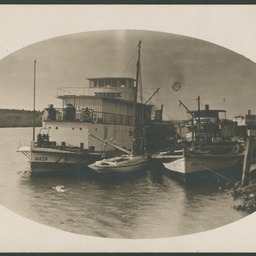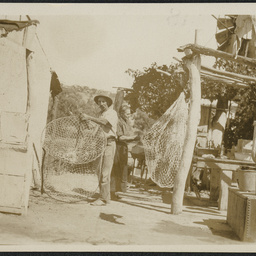Find • murray • Results 631 to 660 of 5,749


Bridges at Murray Bridge
Photograph of a postcard. General view of the river showing the two bridges. "B.M.H. series no. 6".


Cutting Hay at Murray Flats
Near Morgan cutting hay using horsedrawn binders.


Lady Augusta & Eureka
Drawing of the river steamers 'Lady Augusta' and 'Eureka' on the Murray River. The caption under the lithograph reads: 'Lady Augusta' and 'Eureka' - Captain Cadell's first vessels on the Murray - left the Goolwa on their first trip August 25th 1853, returned Octr 14th 1853'.


Paddle steamer "Tyro"
[General description] Crew and passengers pose for the photographer aboard the moored PS 'Tyro' where a pile of fiewood is stacked at the wharf. The Tyro plied the river from 1872-1926, mostly around the lower Murray and Lake Alexandrina. Badly damaged in November 1897 as a result of a boiler explosion, she was repaired and returned to service until 1926 when she was accidentally destroyed by fire. [On back of photograph] 'River Murray Paddle steamer 'Tyro''.


Paddle steamer Decoy
The Scottish Paddle Steamer "Decoy" was reassembled in Melbourne after being freighted from Renfrew in Scotland. The PS "Decoy" was sailed from Port Phillip Bay to the Murray River mouth in 1879 where she towed barges on the river. Between 1902 and 1905 she towed wheat barges to and from South Australian ports. In 1905 she steamed to Fremantle where the deck was altered to carry excursion passengers. In 1909 after being towed back to the Murray River she continued to operate until 1932.


River steamers on the Murray
River steamers the 'Bourke' and 'Jane Eliza' unloading at the wharf. . "Burke" was built at Milang in 1876 and "Jane Eliza" in 1870. The boats are moored in front of the Wool Store and are loaded with bales of wool. "Burke" was converted from an excursion steamer to a barge c. 1898. There was an earlier barge of the same name.


Fleet of River Steamers
Fleet of Murray River Steamers and barges. Some of the names of the steamers and barges are "Decoy", "Moorara", Mallara", "Isabell", "Mannum", Murrumbidgee".


River steamer "W. F. B"
River steamer "W. F. B". and barge "Annie", River Murray. Next to the steamers stands a large pile of stacked pipes and construction materials. See also PRG 1258/2/62


River steamer "Marion"
River steamer "Marion" was one of the first paddle steamers to run cruises on the Murray River. She was built in 1896 at Milang to be both a work boat and pleasure craft. The owner died before she was finished so she was made into a barge and later into a paddle steamer. She began life as a hawking steamer our of Echuca. She had an engine which was imported from England. In 1908 she was stripped of her store buildings and rebuilt with accommodation for 8 passengers. She travelled upstream to Renmark then down to Goolwa and back to Morgan.


River Steamer, South Australia
River Steamer, "South Australian" with barge at Wilcannia. She weighed 152 tons and operated on the River Murray from 1878 to 1902. She won a towing contest between the "Rothbury" in 1892. She was operated by flour miller on Tam O'Shanter Creek from 1902


'Corowa', river steamer
River steamer and barge at Wentworth.


"Queen", River Steamer
Views of the "Queen", river steamer, and "Bourke", barge on the Murray.


River Steamer "Marion"
"Marion" passing under the Wentworth Bridge on the River Murray.


"Marion", River Steamer
"Marion" and empty barge on the River Murray. According to a researcher, the location is Wentworth wharf, Darling River.


River steamer "Etona"
River steamer "Etona" and unidentified steamer on the Murray River.


Chowilla Homestead
Chowilla Homestead on the Murray River.


Burnell's rowing boat
Rowing boat used by G. Burnell and E.W. Cole who descended the Murray River from Echuca to Goolwa (approximately 1,500 river miles) at the river's mouth in 1862.


Murray River floods
Sheep crossing the river on flooded country.


"Ellen", River Steamer
The "Ellen" and the barge "Paika" on the Murray River.


"Goldsbrough", River Steamer
The "Goldsbrough" and two barges on the Murray River.


"Goldsbrough", River Steamer
The "Goldsbrough" and two barges on the Murray River.


A Fisherman's Hut
A fisherman's hut by the River Murray.


Survey Camp
Survey Camp by the Murray River.


'Captain Sturt' SWPS pushing bin barges on the Murray River
Towing barges. [Identified by Frank Tucker as 'Captain Sturt' SWPS pushing bin barges laden with crushed rock for lock construction'.]


Aborigine swagmen
Three Aboriginal swagmen by the River Murray.


Surveyors' camp
Part of a surveyor's camp near the Murray River.


Surveyors' camp
Part of a surveyor's camp, near the Murray River.


Pyap, River Murray
Pyap Settlement, River Murray. The Pyap settlement commenced in March 1894 and was abandoned in 1903. One of the problems of the settlement was the limited experience of its settlers. They did not want to work communally. Irrigation was another problem and the lack of clear management. The name Pyap is believed to have come from the Aboriginal word for a River Murray fish. The photograph shows workers near a grinding stone and a furnace can be seen buring in the background


Pyap, River Murray
Pyap Settlement, River Murray. The Pyap settlement commenced in March 1894 and was abandoned in 1903. One of the problems of the settlement was the limited experience of its settlers. They did not want to work communally. Irrigation was another problem and the lack of clear management. The name Pyap is believed to have come from the Aboriginal word for a River Murray fish. This photograph shows members of the settlement outside a shelter. Under this shelter women and children can be seen enjoying afternoon tea around a table dressed with a tablecloth


Pyap, River Murray
Pyap Settlement, River Murray. The Pyap settlement commenced in March 1894 and was abandoned in 1903. One of the problems of the settlement was the limited experience of its settlers. They did not want to work communally. Irrigation was another problem and the lack of clear management. The name Pyap is believed to have come from the Aboriginal word for a River Murray fish. This photograph shows all the settlers near around the irrigation pump and boiler. There seem to be an equal number of men and women
